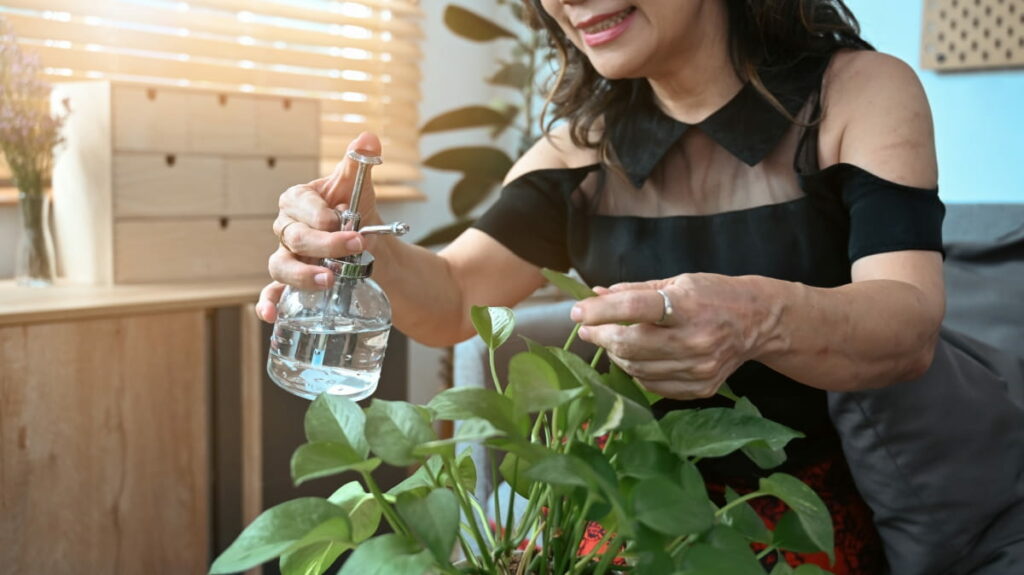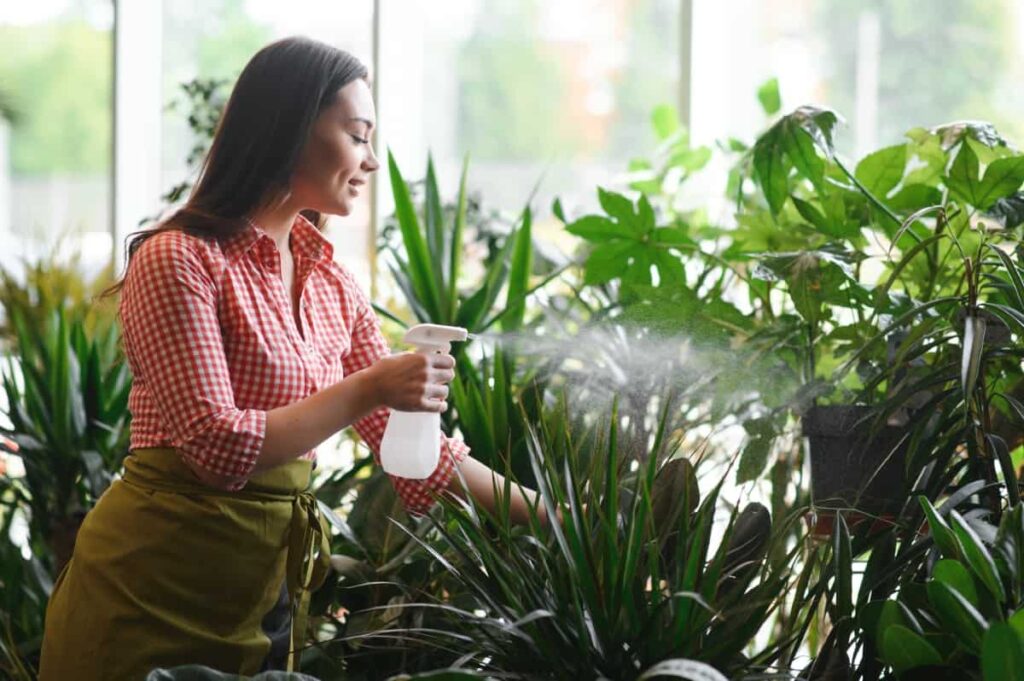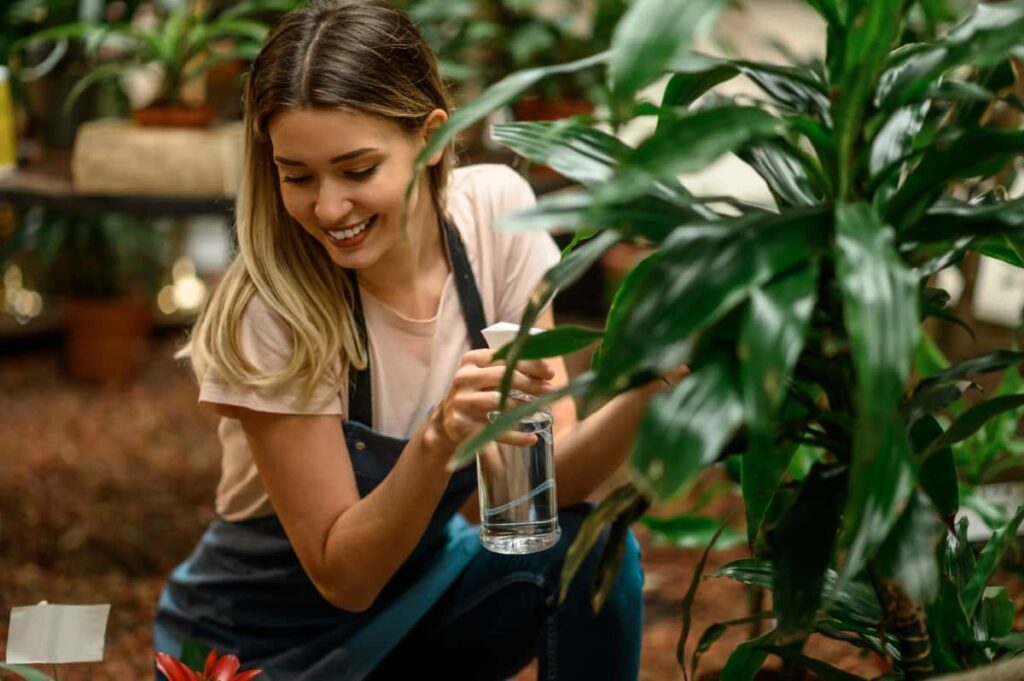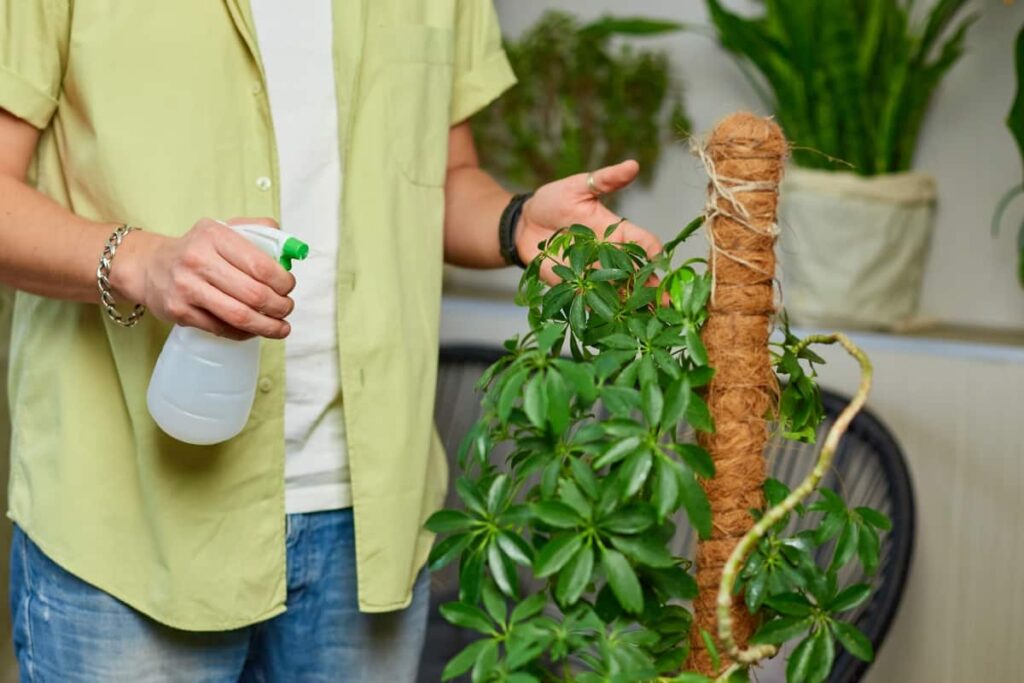Thrips are tiny, winged insects that wreak havoc on houseplants by sucking sap from leaves and flowers, leaving behind silvery trails and causing foliage to distort or die. These pests are often challenging to spot due to their minuscule size and preference for hiding in plant crevices. Despite their small stature, thrips can quickly multiply, infesting indoor gardens and compromising plant health. In this guide, we’ll explore DIY methods for houseplant Thrips treatment and restore vitality to your indoor garden.

How to Rid of Thrips on Houseplants
Identifying Thrips Infestation on Houseplants
Signs and Symptoms of Thrips Damage
Look for tiny, slender insects, usually about 1-2 millimeters in length, crawling or flying around the plant. Thrips often leave behind distinctive silver or bronze streaks on leaves and flowers, indicating their feeding activity. Identifying Thrips houseplant damage includes affected foliage that may exhibit curling, distortion, or stippling as thrips pierce plant tissues and suck out sap. Leaves may appear speckled or discolored, and buds may fail to open properly.
Keep an eye out for black fecal matter, called frass, which accumulates on leaves and surfaces around the plant. Severe infestations lead to stunted growth, wilting, and even premature leaf drop. Regular inspection and prompt action to mitigate Thrips on indoor plants and prevent their spread to other plants in indoor gardens.
The Lifecycle of Thrips
Knowing Your Enemy: Thrips Development Stages
- Egg: The life cycle begins when adult female thrips lay eggs, usually within plant tissues or on plant surfaces.
- Larval Stage: Upon hatching, thrips emerge as tiny larvae and undergo two actively feeding stages. These larvae are voracious feeders, causing significant damage to plant tissues.
- Prepupa: After the larval stages, thrips enter a nonfeeding prepupal stage, where they prepare for the next phase of development.
- Pupa: Following the prepupal stage, thrips enter a nonfeeding pupal stage. Despite being referred to as pupae, thrips do not undergo a traditional pupal transformation like many other insects.
- Adult: Finally, the thrips emerge from the pupal stage as fully developed adults, ready to reproduce and continue the cycle.
Preventative Measures for Thrips
Creating a Hostile Environment for Thrips
- Healthy, vigorous plants are better equipped to resist thrips infestations. Ensure proper watering, fertilization, and sunlight to promote plant vitality.
- Conduct routine inspections of houseplants for early signs of thrips infestation. Promptly remove any affected plant parts to prevent further spread.
- Use fine mesh screens or row covers to prevent thrips from accessing vulnerable plants. This is particularly useful for outdoor gardens or greenhouse environments.
- Introduce beneficial insects like predatory mites or ladybugs, which feed on thrips and help control their population.
- Apply neem oil spray to houseplants as a natural deterrent against thrips. Neem oil disrupts thrips’ feeding and reproductive capabilities.
Quarantine and Inspection Strategies
Preventing the Spread of Thrips in New Additions
- As quarantine procedures houseplants Thrips, Place new plant acquisitions in quarantine for at least two to four weeks to monitor for signs of thrips or other pests before integrating them into your indoor garden.
- Examine new plants carefully, paying close attention to the undersides of leaves and along stems for any signs of thrips, such as feeding damage or the presence of the insects themselves.
- Keep newly acquired plants separate from existing houseplants until they have been confirmed free of thrips. This prevents potential infestations from spreading to established plants.
- If thrips are detected, treat the affected plants promptly with appropriate control methods, such as insecticidal soap or neem oil, before introducing them to your indoor garden.
In case you missed it: Management Strategies for Controlling Black Thrips Life Cycle

Natural and Organic Control Methods
Leveraging Biological Controls and Organic Insecticides
Biological Thrips control indoors involves Introducing predatory insects such as ladybugs, lacewings, or predatory mites can help keep thrips populations in check by preying on them. These natural Thrips remedies indoor plants can be introduced into your indoor garden and allowed to establish populations, providing ongoing protection against thrips.
As organic Thrips solutions houseplants, insecticides derived from plant-based ingredients or natural compounds are another effective option for controlling thrips. Neem oil disrupts thrips’ feeding and reproductive processes, effectively reducing their numbers without harming beneficial insects or the environment. As safe indoor plant pesticides for Thrips, Insecticidal soaps consist of potassium salts of fatty acids that target thrips while minimizing risks to humans, pets, and beneficial insects.
Chemical Control Options for Thrips
When and How to Use Chemical Pesticides Safely
Opt for pesticides containing active ingredients like spinosad, pyrethrins, or imidacloprid for preventing Thrips on houseplants. Apply pesticides at the first signs of thrips activity, typically during the early stages of infestation. Treat both upper and lower leaf surfaces thoroughly, as thrips often hide in crevices.
Exercise caution when using chemical pesticides, wearing protective gear such as gloves, goggles, and a mask to prevent exposure. Keep children and pets away from treated areas until the pesticide has dried completely. To minimize environmental impact, avoid applying pesticides during windy conditions or before rain. Dispose of empty pesticide containers according to local regulations.
DIY Solutions for Thrips Removal
Home Remedies to Combat Thrips Infestations
- Neem Oil Thrips Houseplants: Dilute neem oil in water and apply it to affected plants. Neem oil disrupts thrips’ feeding and reproductive cycles.
- Insecticidal Soap for Indoor Thrips: Mix insecticidal soap with water and spray it onto plants to suffocate and kill thrips on contact.
- Garlic and Pepper Spray: Blend garlic cloves and hot peppers with water, strain the mixture, and use it as a spray to repel and deter thrips.
- Diatomaceous Earth (DE): Sprinkle DE on the soil surface to create a barrier that deters thrips from infesting plant roots.
- Sticky Traps: Place yellow sticky traps near affected plants to catch adult thrips flying around.
In case you missed it: Management Strategies for Black Thrips in Horticultural Crops

Recovery and Care for Thrips-Damaged Plants
Healing and Reviving Infested Houseplants
- Trim-Affected Foliage: Prune away damaged leaves and flowers to promote new growth and remove hiding spots for remaining thrips.
- Improve Air Circulation: Increase ventilation around plants by spacing them apart and ensuring adequate airflow. This discourages thrips infestations and promotes plant vigor.
- Watering and Fertilization: Maintain proper watering and fertilization practices to support plant recovery. Avoid overwatering, as damp conditions can attract pests.
- Houseplant Soil Treatment Thrips: Repot plants in fresh, nutrient-rich soil to replenish depleted nutrients and provide a healthy growing environment.
- Monitoring Thrips in Indoor Plants: Keep a close eye on plants for any signs of thrips resurgence and promptly address any new infestations.
- Implement Preventative Measures: Continue practicing preventive measures such as regular inspection, quarantine of new plants, and natural pest control methods to deter future thrips infestations.
In case you missed it: Easy Homemade Fertilizer Recipes: Natural and Organic for Houseplants, Flowers, and Garden Plants

Conclusion
Effectively DIY Thrips control houseplants methods require a multi-faceted approach. By implementing natural remedies, you can combat thrips infestations while minimizing harm to your plants and the environment. With diligence and systemic houseplant Thrips treatments, a thrips-free indoor garden is achievable.
- Crops Grown in Summer Season: Best Choices for Summer Gardening
- Organic Pest Control for Tomato Farming
- How to Maximize Sheep Farming Profit
- Broccoli Varieties: Choosing the Right Cultivars for Your Farm
- How to Raise Pigs in Your Own Backyard: A Comprehensive Guide
- Budget Friendly Sheep Shed Ideas: Cheap and Low-Cost Tips
- How Much Do Cattle Farmers Make: Revenue Streams in Cattle Farming
- Management Pests and Diseases in Your Cotton Field
- Sheep Farming Business Plan for Beginners
